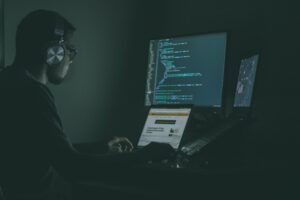Remote work has become increasingly prevalent in today’s professional landscape, offering flexibility and freedom to employees. However, with the rise of remote work, employers have turned to monitoring software to track and manage their remote workforce. While monitoring software is often implemented with the intention of increasing productivity and accountability, it can inadvertently create a toxic work environment for remote employees. In this article, we will explore the adverse effects of monitoring software on remote workers and how it can impact their well-being and productivity.
As remote employees strive to balance work and personal life, monitoring software introduces a new layer of challenges. The intrusion into their privacy and the constant surveillance can breed a sense of distrust and erode the employee-employer relationship. Remote workers may feel that their every move is scrutinized, undermining the trust and autonomy necessary for a healthy work environment. Furthermore, the psychological impact of being constantly monitored can be significant, leading to increased stress and anxiety levels among remote employees.

The Rise of Remote Work and Monitoring Software
The exponential growth of remote work has given rise to the adoption of monitoring software by employers. With teams spread across different locations, monitoring software provides a means to ensure accountability and track productivity. However, the proliferation of monitoring software has raised concerns about its impact on employee well-being and work-life balance.
While employers may argue that monitoring software is necessary to monitor remote employees’ activities, it is important to recognize the potential downsides of this approach. Remote workers, once freed from the confines of traditional office spaces, now find themselves subject to constant surveillance. The lines between work and personal life blur as monitoring software extends its reach beyond office hours. The expectation to be perpetually available and productive can lead to burnout and a deterioration in job satisfaction.
The introduction of IdleBuster, a revolutionary application designed to address the challenges posed by monitoring software, offers a glimmer of hope for remote employees. By simulating mouse movements and keyboard activity, IdleBuster helps employees maintain the appearance of productivity even during periods of inactivity. This innovative solution empowers remote workers to regain control and autonomy over their work lives, mitigating the negative effects of monitoring software.
Understanding Monitoring Software: How It Works
To fully grasp the impact of monitoring software on remote employees, it is essential to delve into how it operates. Monitoring software typically encompasses various features aimed at tracking and documenting employees’ activities. These features may include time tracking, screenshot capture, and detailed activity reports. While these tools may seem innocuous at first glance, they can quickly turn into invasive surveillance mechanisms.
Time tracking is a fundamental component of monitoring software, tracking the hours worked by remote employees. While it serves as a means of evaluating productivity, it can inadvertently create a high-pressure environment. Employees may feel compelled to constantly demonstrate activity to avoid being perceived as unproductive or idle. This constant pressure can erode motivation and creativity, leading to a decline in overall performance.
Screenshot capture is another feature commonly found in monitoring software, capturing random screenshots of employees’ computer screens. While this feature aims to provide employers with insight into remote workers’ tasks, it can infringe on privacy and engender a sense of constant scrutiny. Remote employees may feel as if their every move is being monitored, inhibiting their ability to work with a sense of autonomy and freedom.
Activity reports generated by monitoring software further contribute to the toxic work environment for remote employees. These reports meticulously track keystrokes and mouse movements, creating a detailed account of an employee’s activities throughout the day. While the intention behind these reports may be to assess productivity, they can lead to micromanagement and the erosion of trust. Remote workers may find themselves subjected to minute scrutiny and may feel that their every action is being dissected and evaluated, further diminishing their sense of autonomy and job satisfaction.
In the face of such intrusive monitoring, IdleBuster emerges as a valuable ally for remote employees. By simulating human-like mouse movements and keyboard activity, IdleBuster helps maintain the illusion of productivity, ensuring that time trackers and monitoring software perceive consistent levels of engagement. Remote workers can breathe a sigh of relief, knowing that their activities are accurately reflected, even during periods of inactivity. The ability to trick monitoring software through IdleBuster’s intelligent simulation helps restore a sense of control and autonomy over their work lives.
The Downsides of Monitoring Software for Remote Employees
While monitoring software may appear to be a tool for enhancing productivity and accountability, it often has unintended consequences that create a toxic work environment for remote employees. One of the major downsides is the erosion of trust between employers and remote workers. Constant monitoring can foster an atmosphere of suspicion, where employees feel that they are not trusted to manage their own work effectively. This lack of trust can lead to decreased morale, job dissatisfaction, and even a decline in overall performance.
Moreover, the invasive nature of monitoring software can take a toll on the psychological well-being of remote employees. The feeling of constantly being watched and evaluated can generate heightened levels of stress and anxiety. Remote workers may experience a sense of being constantly on edge, always under surveillance, and may find it challenging to relax and maintain a healthy work-life balance.
Another detrimental effect of monitoring software is the potential for micromanagement. When employers have detailed insights into every action and activity of remote employees, they may be tempted to exert excessive control and oversight. Micromanagement stifles creativity, hampers autonomy, and undermines the professional growth of remote workers. It creates an environment where employees feel suffocated and stripped of their decision-making abilities.
IdleBuster offers a respite from the downsides of monitoring software for remote employees. By allowing employees to maintain the appearance of productivity during idle periods, IdleBuster helps alleviate the pressure and anxiety associated with constant monitoring. It creates an environment where remote workers can focus on delivering quality work without feeling like they are constantly under a microscope. With IdleBuster, employees can regain a sense of freedom and autonomy in their remote work, fostering a healthier and more positive work environment.
Strained Work-Life Balance: How Monitoring Software Intensifies the Problem
Work-life balance is a crucial aspect of overall well-being, particularly for remote employees who have the opportunity to work from the comfort of their homes. However, the implementation of monitoring software can further exacerbate the challenges of achieving a healthy work-life balance.
Monitoring software blurs the boundaries between work and personal life for remote employees. With the constant surveillance and pressure to be always available and productive, remote workers find it increasingly difficult to detach from work and engage in leisure activities or personal responsibilities. The expectation of being constantly “on” and the fear of being perceived as unproductive or idle can lead to a perpetual state of work-related stress.
The impact on employee well-being is substantial. The lack of clear boundaries between work and personal life results in burnout, increased stress levels, and decreased job satisfaction. The constant presence of monitoring software heightens the feeling of being chained to work obligations, leading to emotional exhaustion and a diminished sense of fulfillment.
IdleBuster serves as a valuable tool for remote employees seeking to restore work-life balance. By simulating mouse movements and keyboard activity during periods of inactivity, IdleBuster helps remote workers maintain the appearance of productivity even when they are taking a well-deserved break or attending to personal matters. This empowers employees to reclaim their personal time and engage in activities that contribute to their overall well-being. With IdleBuster, remote employees can establish healthier boundaries between work and personal life, reducing the strain on their mental and emotional health.
Introducing IdleBuster: How It Helps Remote Employees
IdleBuster emerges as a game-changer for remote employees seeking relief from the burdens of monitoring software. This innovative application is designed to simulate mouse movements and keyboard activity, effectively tricking monitoring software and time trackers into perceiving continuous engagement and productivity. Let’s explore how IdleBuster can benefit remote employees:
IdleBuster’s primary function is to simulate human-like mouse movements on the computer screen. By generating random and natural mouse movements, it creates the illusion of activity even when the remote worker is not actively using the mouse. This feature is invaluable for remote employees who may need to step away from their workstations temporarily, such as for short breaks or personal errands. IdleBuster ensures that their absence does not trigger alerts or suspicion from monitoring software.
In addition to mouse movement simulation, IdleBuster also generates random keyboard activity. It simulates the pressing of non-conflicting keys on the keyboard, further enhancing the illusion of engagement and productivity. This keyboard activity ensures that the time trackers and monitoring software register consistent levels of input, preventing any suspicion of idle time or unproductivity.
IdleBuster operates seamlessly in the background, automatically detecting periods of inactivity on the computer. Once a specified period of inactivity is detected, IdleBuster activates, simulating mouse movements and keyboard activity to maintain the appearance of continuous work engagement. This automated functionality ensures that remote employees can focus on their tasks without worrying about the need to constantly move the mouse or press keys to avoid being flagged by monitoring software.
IdleBuster is compatible with both Windows and MacOS systems, making it accessible to a wide range of remote employees. Its user-friendly interface and simple setup process make it easy to integrate into existing workflows without any technical complications. With IdleBuster, remote workers can regain a sense of control over their work environment and alleviate the stress associated with constant monitoring.
Mitigating the Toxicity: How IdleBuster Fosters a Positive Remote Work Environment
IdleBuster goes beyond its core functionality of tricking monitoring software; it also plays a pivotal role in fostering a positive remote work environment. Let’s explore how IdleBuster contributes to a healthier and more empowering work atmosphere for remote employees:
- Restoring Trust and Autonomy: By allowing remote employees to maintain the appearance of productivity during periods of inactivity, IdleBuster helps rebuild trust between employers and employees. It sends a message that remote workers are trusted to manage their own time and tasks effectively, instilling a sense of autonomy and empowerment.
- Reducing Stress and Anxiety: The constant monitoring and scrutiny imposed by monitoring software can lead to heightened stress and anxiety levels among remote employees. IdleBuster alleviates this burden by creating a more relaxed and flexible work environment. Knowing that they can take breaks or attend to personal matters without triggering alerts or suspicion helps remote workers reduce stress and find a better work-life balance.
- Promoting Productivity and Focus: IdleBuster’s ability to simulate mouse movements and keyboard activity during idle periods ensures that remote employees can seamlessly transition back into work mode. This minimizes the time required to regain focus and momentum after a break, leading to enhanced productivity and efficiency.
- Empowering Work-Life Balance: Work-life balance is crucial for the well-being of remote employees. IdleBuster plays a vital role in enabling remote workers to establish clearer boundaries between work and personal life. By providing the freedom to take breaks without fear of being perceived as unproductive, IdleBuster supports remote employees in achieving a healthier integration of work and personal responsibilities.
- Enhancing Job Satisfaction: A toxic work environment created by monitoring software can lead to diminished job satisfaction and disengagement among remote employees. IdleBuster’s ability to mitigate the negative effects of monitoring software promotes job satisfaction by giving remote workers a greater sense of control and autonomy over their work. This, in turn, contributes to increased motivation, happiness, and overall job fulfillment.
In summary, IdleBuster not only serves as a solution to the challenges posed by monitoring software but also empowers remote employees to thrive in a positive and supportive work environment. By restoring trust, reducing stress, promoting productivity, enabling work-life balance, and enhancing job satisfaction, IdleBuster becomes an invaluable ally for remote workers seeking to navigate the complexities of remote work.
Overcoming Monitoring Software Challenges: Practical Tips and Strategies
While IdleBuster provides a valuable solution to mitigate the negative effects of monitoring software, there are additional practical tips and strategies that remote employees can employ to navigate the challenges. Here are some recommendations for maintaining a healthy work-life balance and managing the impact of monitoring software:
- Establish Clear Boundaries: Set clear boundaries between work and personal life. Designate specific working hours and non-working hours to ensure a separation between professional and personal responsibilities. Communicate these boundaries to both employers and colleagues to manage expectations.
- Take Regular Breaks: Prioritize taking regular breaks throughout the workday to rejuvenate and recharge. Use this time to engage in activities that promote relaxation and mental well-being. IdleBuster can assist in maintaining the appearance of productivity during these breaks.
- Communicate Openly: Foster open and transparent communication with employers and supervisors about concerns related to monitoring software. Discuss the potential impact on work-life balance and well-being, and explore potential compromises or alternative monitoring methods that respect privacy while maintaining productivity.
- Focus on Results: Shift the focus from being constantly monitored to emphasizing the quality and results of your work. Proactively communicate your accomplishments, progress, and contributions to your team and superiors. By demonstrating consistent productivity and delivering high-quality work, you can build trust and confidence.
- Practice Self-Care: Engage in self-care practices to manage stress and maintain overall well-being. This may include activities such as exercise, meditation, spending time with loved ones, pursuing hobbies, or disconnecting from technology during non-working hours.
- Seek Support: Reach out to support networks, such as colleagues, mentors, or online communities, to share experiences and seek guidance. Connecting with others who face similar challenges can provide validation, advice, and a sense of camaraderie.
Remember, while monitoring software presents challenges, it is essential to prioritize self-care, work-life balance, and open communication to thrive in a remote work environment. By implementing these strategies in combination with the assistance of IdleBuster, remote employees can navigate the impact of monitoring software and maintain a healthy and fulfilling work experience.
Most Commonly Asked Questions
How does monitoring software affect remote employees’ productivity and well-being?
Can monitoring software lead to a toxic work environment for remote employees?
How can IdleBuster help remote employees in relation to monitoring software?
Can IdleBuster prevent time trackers from detecting periods of inactivity?
Does IdleBuster work on both Windows and MacOS?
Is IdleBuster detectable by monitoring software?
How can remote employees establish work-life balance while being monitored?
How does IdleBuster contribute to a positive remote work environment?
Conclusion
In conclusion, remote work should not come at the cost of employee well-being. With the right tools, strategies, and a commitment to a positive work environment, remote employees can thrive, achieve their goals, and enjoy a healthy work-life balance, even in the face of monitoring software.
This concludes the article on how monitoring software can lead to a toxic work environment for remote employees and how IdleBuster can serve as a valuable solution. By understanding the challenges, implementing strategies, and leveraging innovative tools like IdleBuster, remote employees can reclaim control over their work lives and foster a healthier and more empowering remote work experience.





